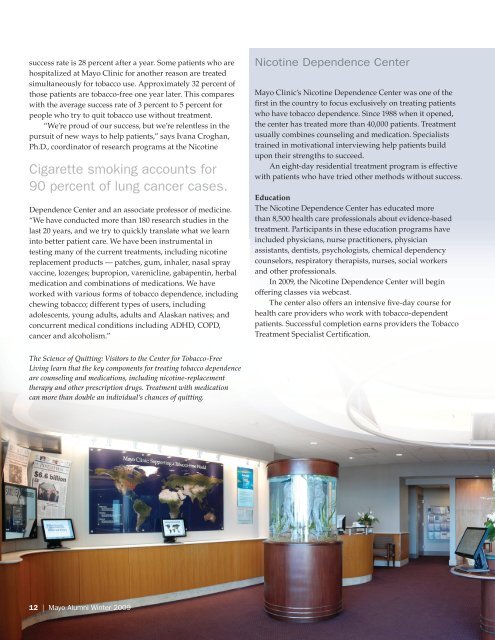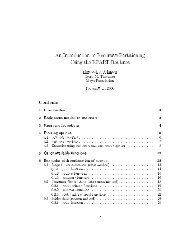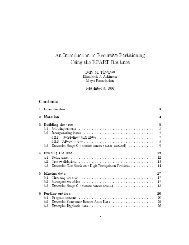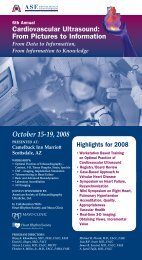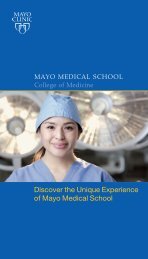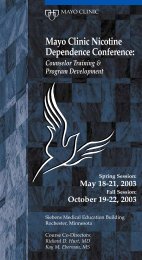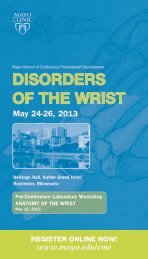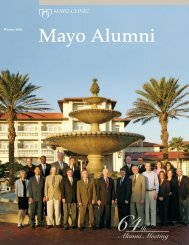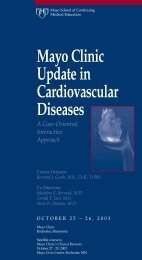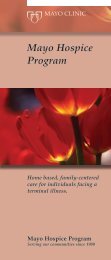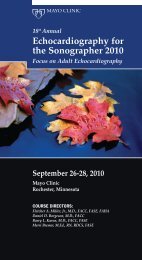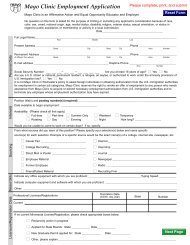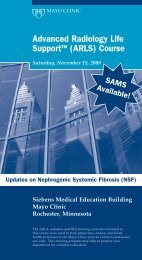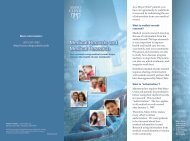Winter 2008-2009 - Mayo Clinic
Winter 2008-2009 - Mayo Clinic
Winter 2008-2009 - Mayo Clinic
Create successful ePaper yourself
Turn your PDF publications into a flip-book with our unique Google optimized e-Paper software.
success rate is 28 percent after a year. Some patients who are<br />
hospitalized at <strong>Mayo</strong> <strong>Clinic</strong> for another reason are treated<br />
simultaneously for tobacco use. Approximately 32 percent of<br />
those patients are tobacco-free one year later. This compares<br />
with the average success rate of 3 percent to 5 percent for<br />
people who try to quit tobacco use without treatment.<br />
“We’re proud of our success, but we’re relentless in the<br />
pursuit of new ways to help patients,” says Ivana Croghan,<br />
Ph.D., coordinator of research programs at the Nicotine<br />
Cigarette smoking accounts for<br />
90 percent of lung cancer cases.<br />
Dependence Center and an associate professor of medicine.<br />
“We have conducted more than 180 research studies in the<br />
last 20 years, and we try to quickly translate what we learn<br />
into better patient care. We have been instrumental in<br />
testing many of the current treatments, including nicotine<br />
replacement products — patches, gum, inhaler, nasal spray<br />
vaccine, lozenges; bupropion, varenicline, gabapentin, herbal<br />
medication and combinations of medications. We have<br />
worked with various forms of tobacco dependence, including<br />
chewing tobacco; different types of users, including<br />
adolescents, young adults, adults and Alaskan natives; and<br />
concurrent medical conditions including ADHD, COPD,<br />
cancer and alcoholism.”<br />
Nicotine Dependence Center<br />
<strong>Mayo</strong> <strong>Clinic</strong>’s Nicotine Dependence Center was one of the<br />
first in the country to focus exclusively on treating patients<br />
who have tobacco dependence. Since 1988 when it opened,<br />
the center has treated more than 40,000 patients. Treatment<br />
usually combines counseling and medication. Specialists<br />
trained in motivational interviewing help patients build<br />
upon their strengths to succeed.<br />
An eight-day residential treatment program is effective<br />
with patients who have tried other methods without success.<br />
Education<br />
The Nicotine Dependence Center has educated more<br />
than 8,500 health care professionals about evidence-based<br />
treatment. Participants in these education programs have<br />
included physicians, nurse practitioners, physician<br />
assistants, dentists, psychologists, chemical dependency<br />
counselors, respiratory therapists, nurses, social workers<br />
and other professionals.<br />
In <strong>2009</strong>, the Nicotine Dependence Center will begin<br />
offering classes via webcast.<br />
The center also offers an intensive five-day course for<br />
health care providers who work with tobacco-dependent<br />
patients. Successful completion earns providers the Tobacco<br />
Treatment Specialist Certification.<br />
The Science of Quitting: Visitors to the Center for Tobacco-Free<br />
Living learn that the key components for treating tobacco dependence<br />
are counseling and medications, including nicotine-replacement<br />
therapy and other prescription drugs. Treatment with medication<br />
can more than double an individual’s chances of quitting.<br />
12 | <strong>Mayo</strong> Alumni <strong>Winter</strong> <strong>2009</strong>


